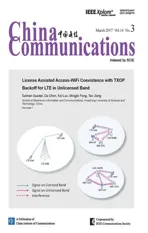Spectrum Allocation for Cognitive Radio Networks with Non-Deterministic Bandwidth of Spectrum Hole
2017-05-09JieHuangXiaopingZengXiaohengTanXinJianYuanHe
Jie Huang, Xiaoping Zeng, Xiaoheng Tan, Xin Jian*, Yuan He
College of Communication Engineering, Chongqing University, Chongqing 400000, China
* The corresponding author, email: jianxin_zg@163.com
I. INTRODUCTION
Radio spectrum is becoming one of the most important and scarcest resources in wireless communication system. However, because of the current spectrum allocation policies,the spectrum utilization efficiency in licensed spectrum is very low [1], which generates many non-continuous vacant frequency bands,referred to as spectrum holes [2]. Cognitive radio (CR) which allows secondary users (SUs)to opportunistically utilize the frequency spectrum originally assigned to licensed primary users (PUs) has be recognized as a promising approach to alleviate spectrum scarcity. In CRNs, spectrum allocation is an important and challenging task which aims to assign the discrete spectrum resources in order to achieve efficient frequency utilization and maximize the capacity.
In the existing literatures, considerable achievements have been made for spectrum allocation in CRNs by the methods of game theory [3-4], graph theory [5-6] and linear programming [7-9], which assume that the pa-rameters of radio environment are static. However, in practice, due to imperfect spectrum sensing, transmission delay and time-varied spectrum environment etc, it is difficult for the secondary network to have the accurate real-time parameters in CRNs, which will make the parameters non-deterministic. Therefore,in fact, static spectrum allocation algorithm without considering non-deterministic parameters may result in frequent spectrum collisions and poor performance. Recently, dynamic resource allocation with non-deterministic parameters in CRNs has received considerable interests from academia, which mainly focus on non-deterministic channel gains and mutual interferences [10-12]. [10] studies the resource allocation for CRNs with non-deterministic signal-to-interference-plus-noise ratio(SINR) and proposes a power control scheme by using water filling algorithm and stochastic programming. On the other hand, [11] studies the distributed resource allocation problem in CRNs by considering the non-deterministic channel gains and the authors propose a robust distributed power control algorithm by applying second order cone programming (SOCP).[12] proposes a robust distributed uplink power allocation algorithm by using worst case robust optimization method, considering the fact that channel gains from SUs to PUs’ base station and interferences caused by PUs to the SUs’ base station are non-deterministic. In addition, most existing works mainly focus on non-deterministic channel gains and mutual interferences. However, due to PU/SU activity and mobility, spectrum environment will change frequently, which result in time-varied bandwidth of spectrum holes. Therefore,exploring a spectrum allocation algorithm by considering non-deterministic bandwidth of spectrum holes is necessary for future CRNs,which will reduce spectrum collisions and greatly improve spectrum efficiency. The prior works about non-deterministic spectrum holes focus more on time-domain spectrum holes, the idle time in a single sub-channel,by adopting Markov process, queuing theory,time series, and ON/OFF periods [13-14].Although these researches have made great achievements, it doesn’t consider non-deterministic bandwidth of spectrum holes in frequency domain. To the best of our knowledge,non-continuous spectrum allocation in CRNs by considering non-deterministic bandwidth of spectrum holes has not been studied in previous works.
This paper studies the non-continuous spectrum allocation problem in CRNs where the bandwidth of spectrum holes is non-deterministic due to PU/SU activity and mobility. We present a novel PDF model through order statistics to describe the non-deterministic bandwidth of spectrum holes and provide a bound to approximate it. This PDF model is different from existing researches which mainly focus on the time durations of spectrum holes [13-14]. By doing so, a statistical spectrum allocation model based on stochastic MKP is established for spectrum allocation with non-deterministic bandwidth of spectrum holes. To reduce the computational complexity, we transform this stochastic programming problem into a constant MKP through exploiting the properties of CDF, which can be solved via MTHG algorithm by using auxiliary variables.Simulation results illustrate that the proposed statistical spectrum allocation algorithm can achieve better performance compared with the existing algorithms when the bandwidth of spectrum holes is time-varied.
The remainder of this paper is organized as follows. The layout problem is described in Section II. In Section III, the statistical model for bandwidth of spectrum holes is presented.In Section IV, the statistical spectrum allocation algorithm based on stochastic MKP method is proposed. Numerical results are provided in Section V to demonstrate the advantages of the proposed scheme. We conclude this paper in Section VI.
In this paper, the authors present a novel PDF model through order statistics to describe the non-deterministic bandwidth of spectrum holes and provide a bound to approximate it.
II. LAYOUT OF PROBLEM
In this work, the multiple SUs access problem in centralized CRNs is studied where each SU access networks through SUs’ base stations within its range. A centralized cognitive radio system includes PUs, SUs, PUs’ base stations and SUs’ base stations, as shown in Fig. 1. In this system, SUs adopt adaptive modulation and coding (AMC) scheme and opportunistically utilize the spectrum holes through spectrum sensing and centralized resource allocation scheme. In spectrum sensing phase,SUs periodically detect the local frequency spectrum information and send it to SUs’ base stations. After that, SUs’ base stations summarize all the detection information from SUs to find spectrum holes and assign the available spectrum resources to SUs by considering different SUs’ needs. We assume that the bandwidth of spectrum holes is time-varied due to PU/SU activity and mobility, which will lead to non-deterministic bandwidth of spectrum holes and make spectrum allocation quite difficult.
In this CRNs system, the spectrum occupancies in frequency domain at a certain time are non-continuous, as depicted in Fig. 2. The totally frequency band is, and the number of
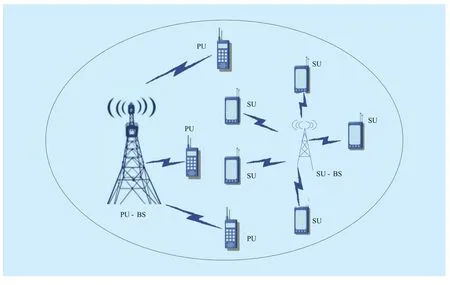
Fig. 1 System model of CRNs

Fig. 2 Spectrum occupancy in frequency domain
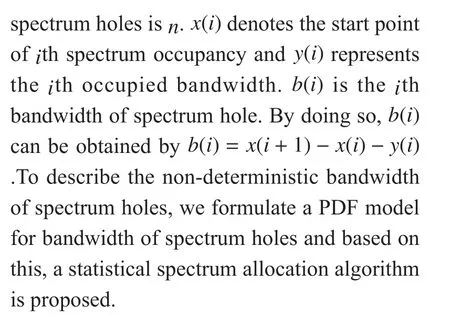
III. STATISTICAL MODEL FOR BANDWIDTH OF SPECTRUM HOLES
In this section, the non-deterministic bandwidth of spectrum holes has been formulated in a mathematic way. We consider the bandwidth of spectrum holes as a part of interval between two adjacent order statistics and represent it through a random variable. Then,based on the properties of two adjacent order statistics, the PDF of bandwidth of spectrum holes can be derived.
Due to PU/SU activity and mobility, the non-continuous PUs’ spectrum occupancies are random distributed in frequency domain,which can be formulated as a random variable following a certain PDF. We assume
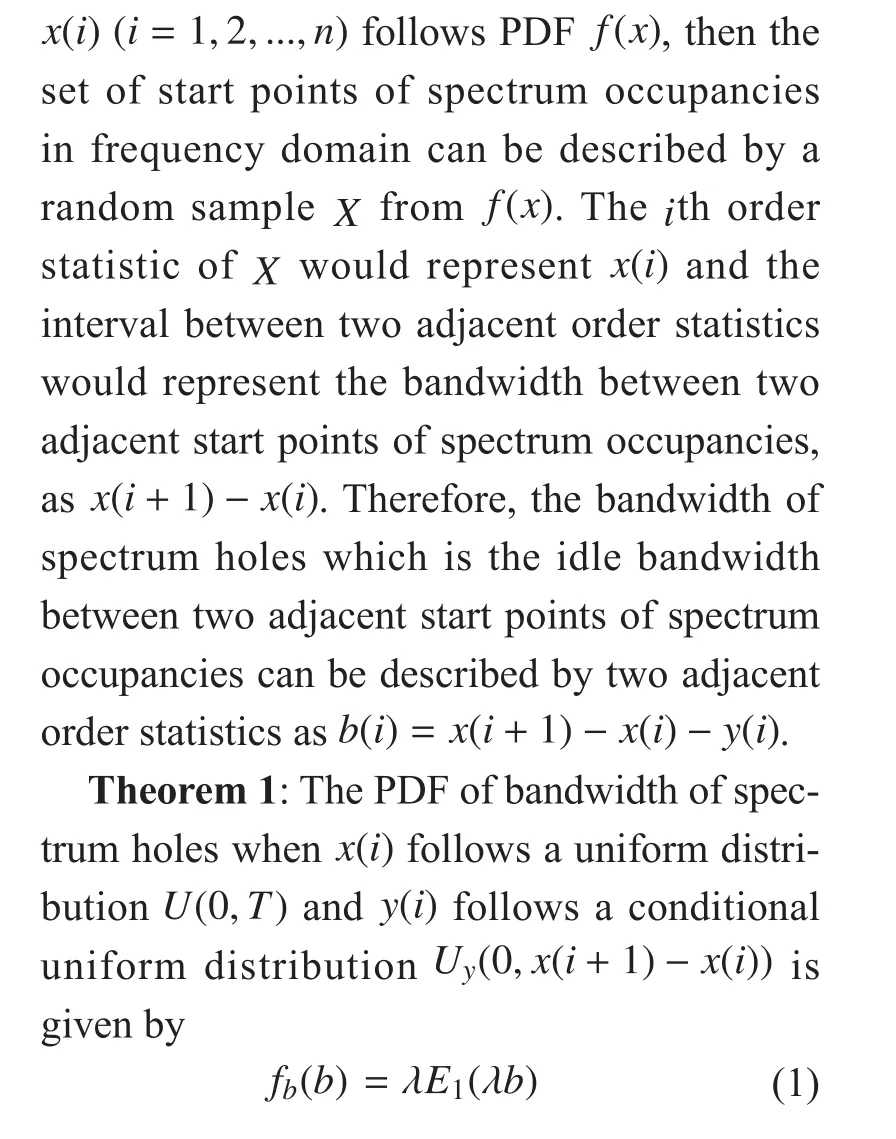


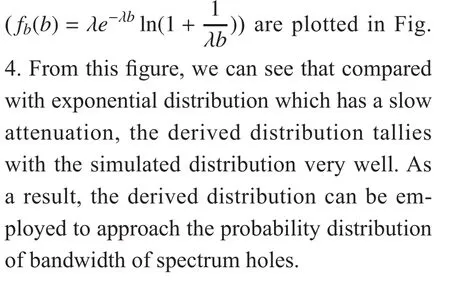
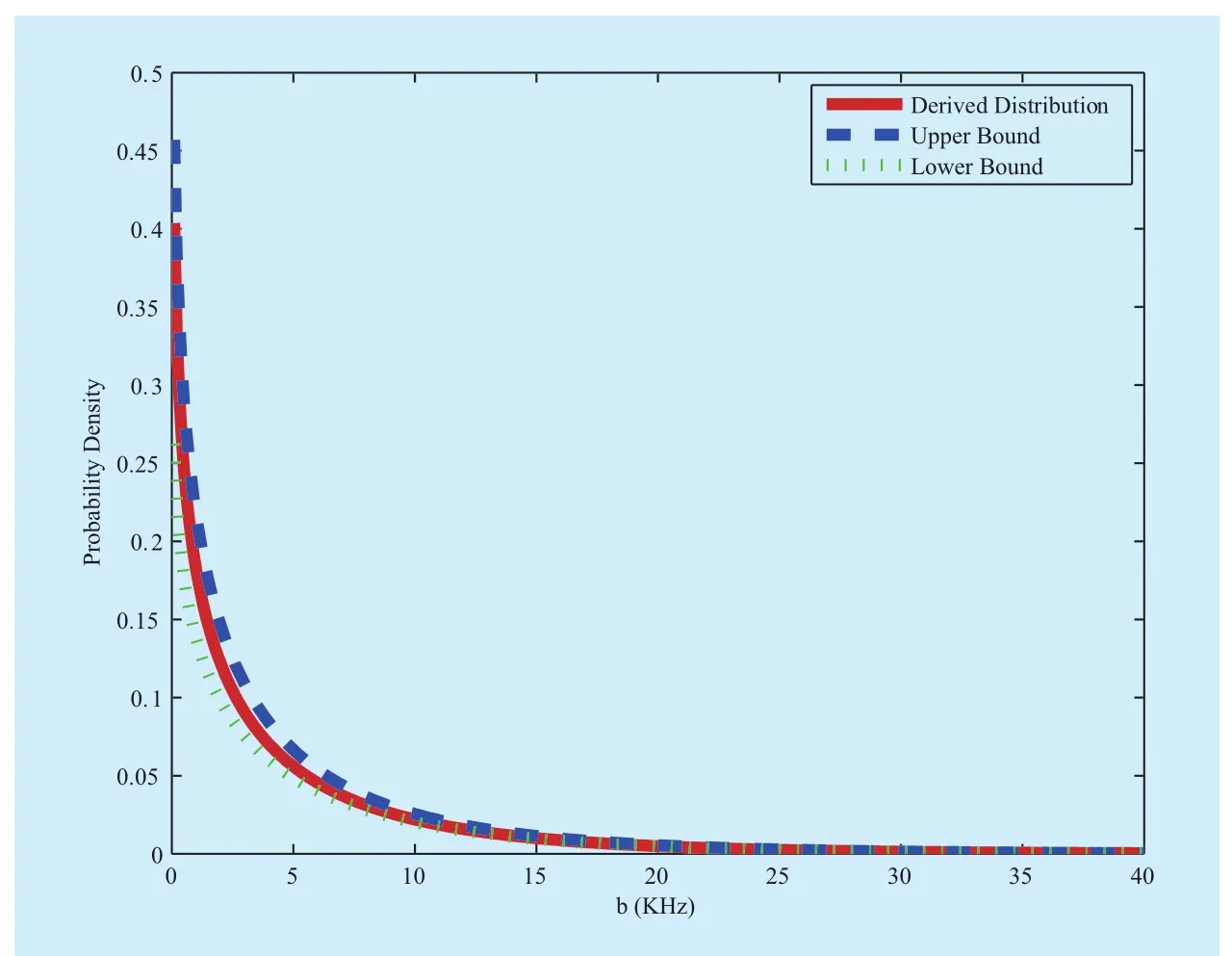
Fig. 3 The upper and lower bounds for fb(b)
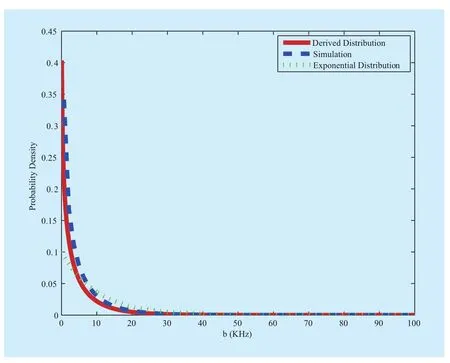
Fig. 4 PDF of bandwidth of spectrum holes when n = 100, T = 1000
IV. STATISTICAL SPECTRUM ALLOCATION ALGORITHM BASED ON STOCHASTIC MKP
4.1 Spectrum allocation model based on stochastic MKP
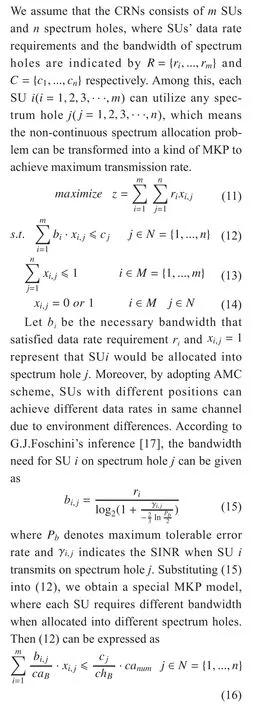
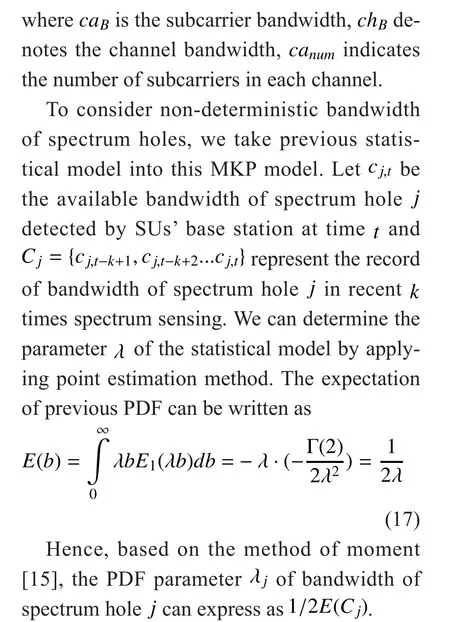
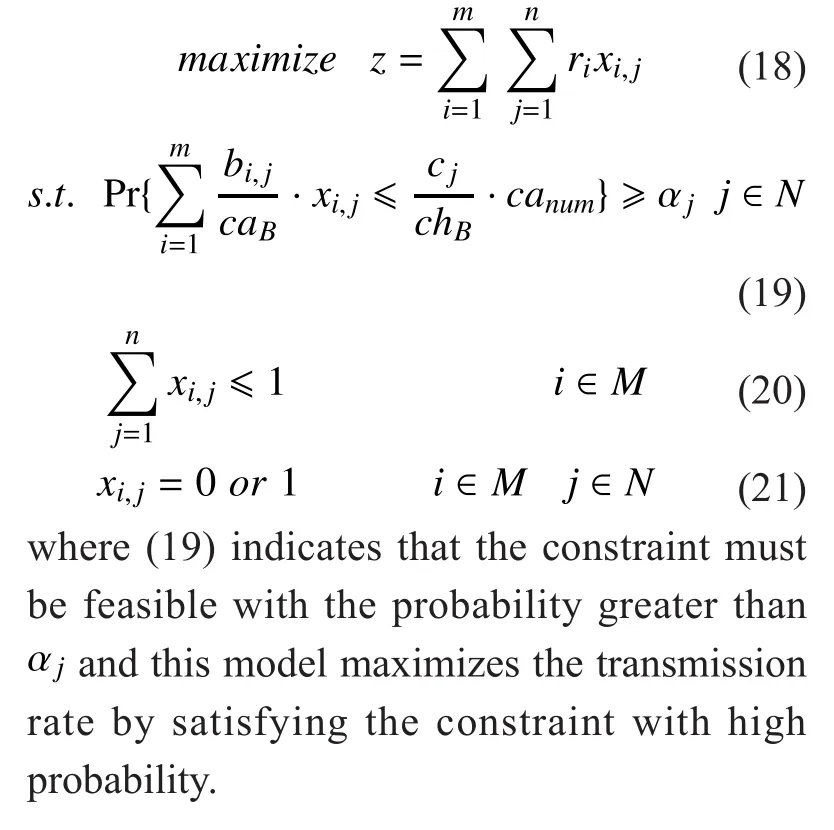
4.2 Simplification and solution

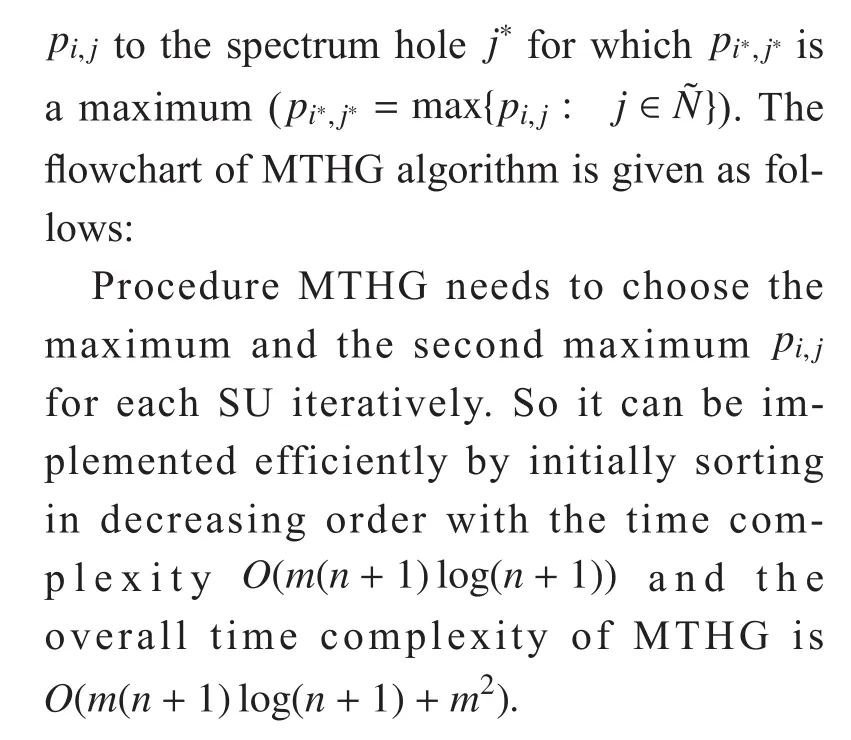
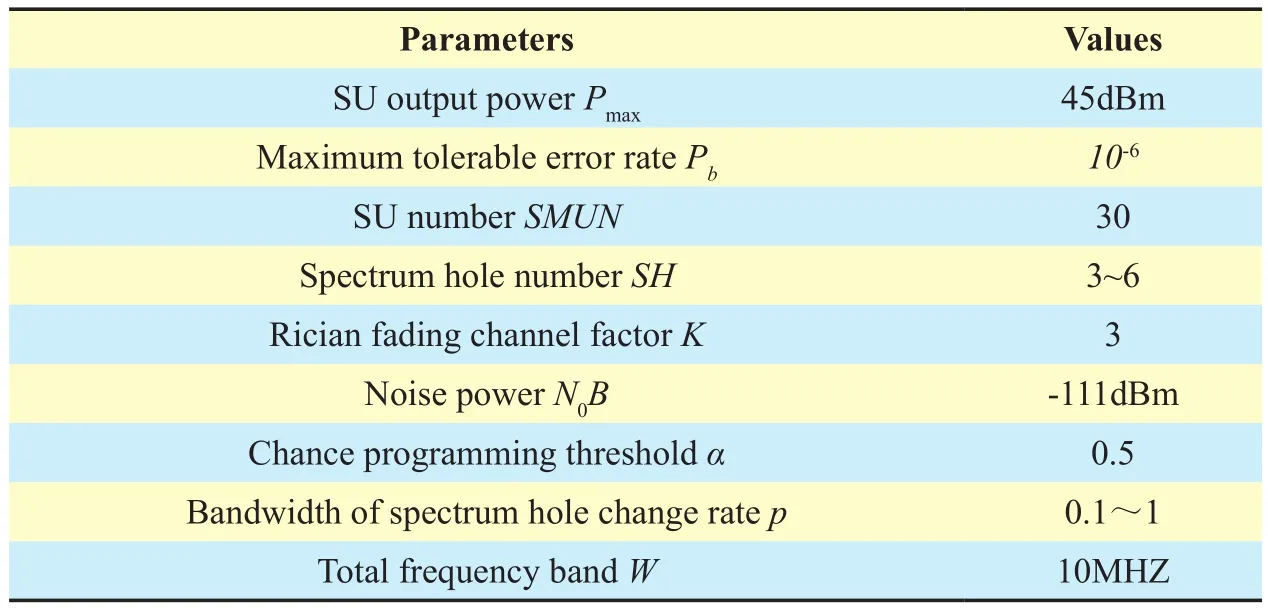
Table I Simulation parameters
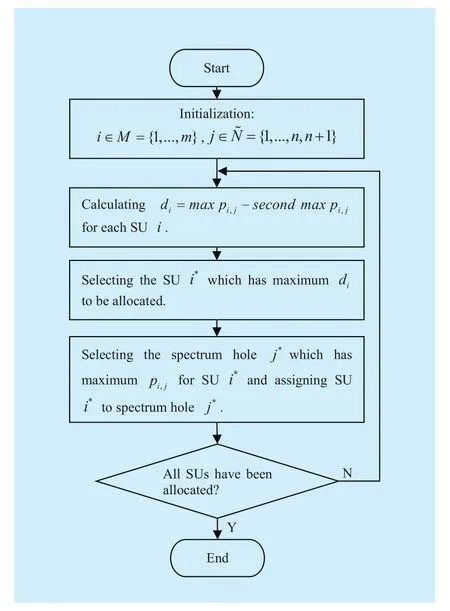
Fig. 5 The flowchart of MTHG algorithm
V. SIMULATION RESULTS
In this section, the performance of proposed statistical spectrum allocation algorithm have be studied through numerical simulations.We assume that all SUs located around the SUs’ base station with the distance randomly ranged from 50 to 2000m and the simulation parameters are set as Table 1. In order to simulate the time-varied bandwidth of spectrum holes caused by PU/SU activity and mobility,we randomly generate spectrum holes with the bandwidth changed through change rate(the probability of bandwidth of spectrum holes changed next moment. Each bandwidth of spectrum hole change will be caused by changingandin the frequency band. Then, we compare the performance of proposed statistical MKP spectrum allocation algorithm with static MKP spectrum allocation algorithm [8] and prediction-based dynamic allocation algorithm LCS-MSA [18].
Fig. 6 illustrates the CDF of SUs’ spectrum efficiency using the three algorithms with different situationsand). As shown in Fig. 6, statistical MKP, static MKP and LCS-MSA occupy 61%, 52% and 62%respectively when the spectrum efficiency is larger than 1.8. This means statistical MKP has similar performance as LCS-MSA which dynamically allocates resources by predicting channel occupation and has higher spectrum efficiency than static MKP when. In addition, asincreases to 1, statistical MKP exceeds LCS-MSA and static MKP, which means statistical MKP can better adapt to the scenario where the bandwidth of spectrum holes changed quickly and achieve higher spectrum efficiency. This case is because LCS-MSA can hardly real-time follow the fast changing spectrum environment and statistical MKP which takes the statistical properties of bandwidth of spectrum holes into consideration can achieve dynamic optimization and reduce bandwidth collisions caused by spectrum holes changes.
In Fig. 7, we evaluate the network utility with different bandwidth change ratesThe network utility is defined as [19]
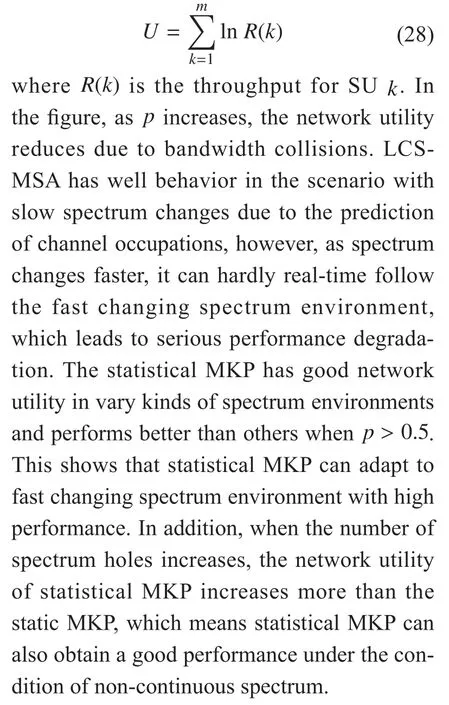
Fig. 8 shows the average spectrum collision rate with different bandwidth change rates p.From Fig. 8, we can see that as p increases, the spectrum collision rate increases dramatically and statistical MKP achieves lower collision rate than others. This is because static MKP only considers current static optimization and uses constant allocation parameters, which may lead to more bandwidth collisions and although LCS-MSA can reduce the collisions by dynamically allocating resources with prediction mechanism, it can hardly predict the time-varied channel occupations when spectrum environment changes fast. The statistical MKP suffers less collision for the reason that it can relax the bandwidth collisions through assigning spectrum resources with considering the statistical properties of spectrum holes.This result shows that statistical MKP algorithm can effectively reduce the spectrum collisions when spectrum holes changes.
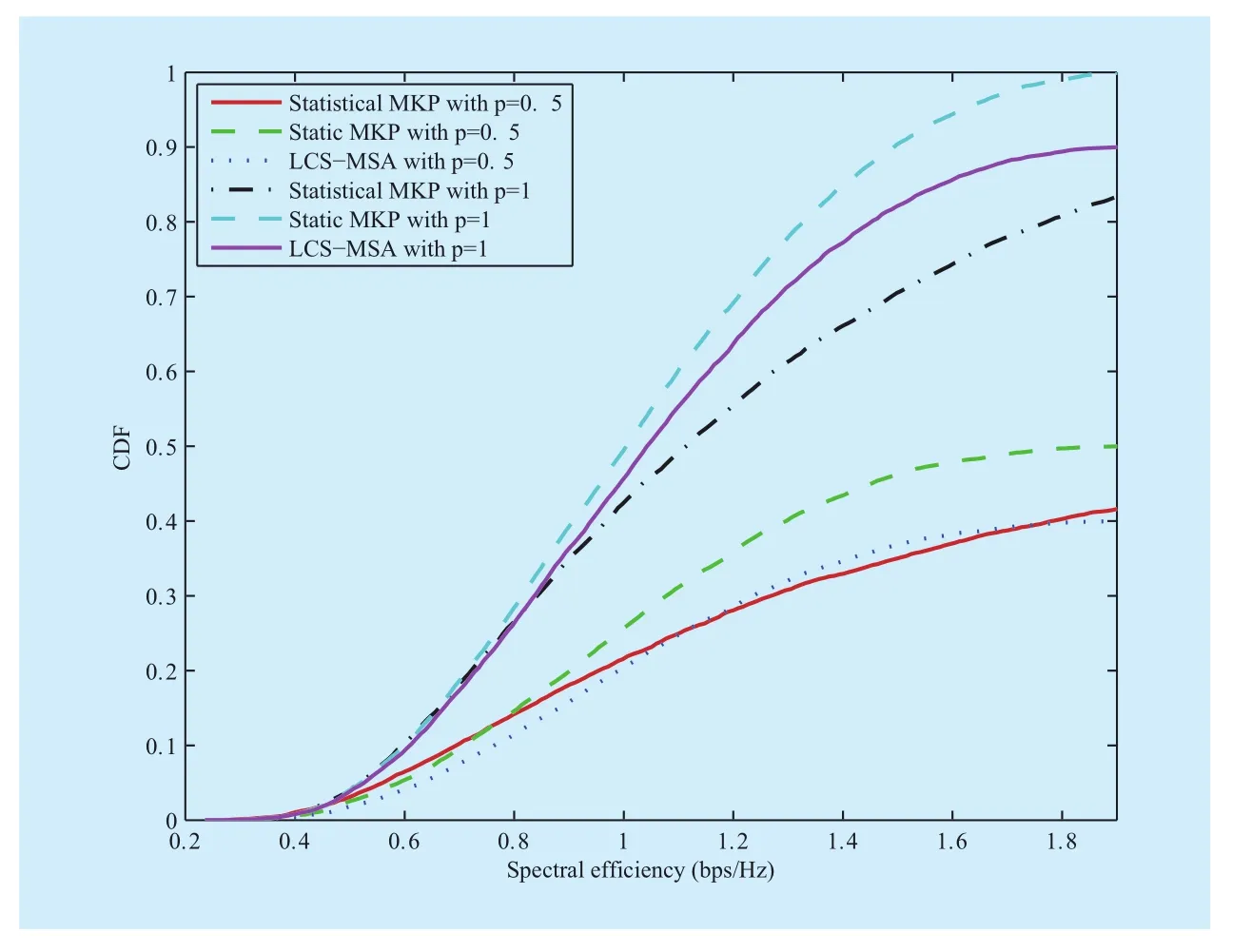
Fig. 6 CDF of spectrum efficiency
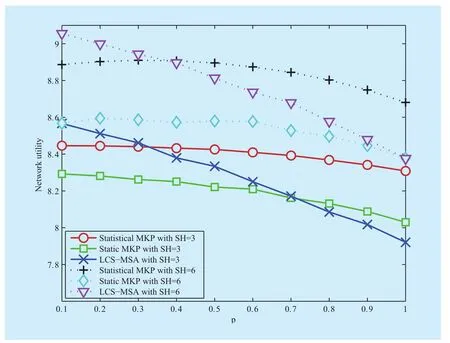
Fig. 7 Network utility with different bandwidth of spectrum holes change rates
VI. CONCLUSIONS
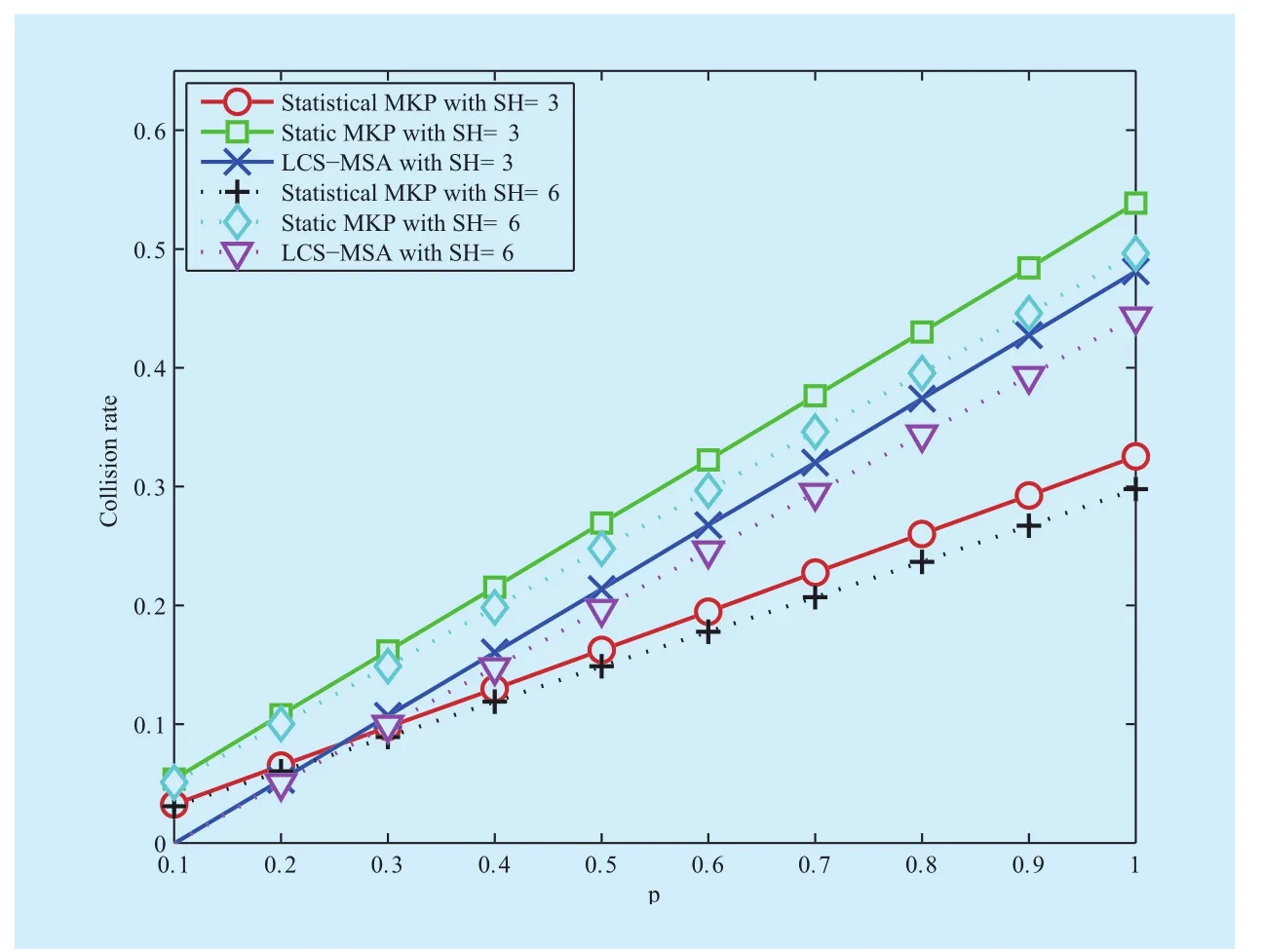
Fig. 8 average spectrum collision rate with different bandwidth of spectrum holes change rates
In this paper, we study the problem of non-continuous spectrum allocation in CRNs where the bandwidth of spectrum holes is non-deterministic due to PU/SU activity and mobility. We present a novel PDF model through order statistics to describe the non-deterministic bandwidth of spectrum holes and provide a bound to approximate it. After that,a statistical spectrum allocation model based on stochastic MKP is established for spectrum allocation with non-deterministic bandwidth of spectrum holes. To reduce the computational complexity, we transform this stochastic programming problem into a constant MKP through exploiting the properties of CDF,which can be solved via MTHG algorithm by using auxiliary variables. Simulation results verify that the proposed statistical spectrum allocation algorithm can achieve better performance compared with the existing algorithms when the bandwidth of spectrum holes is time-varied.
ACKNOWLEDGEMENTS
The authors would like to thank the reviewers for their detailed reviews and constructive comments, which have helped improve the quality of this paper. This work was supported by the National Natural Science Foundation of China (No. 61501065, 91438104, No.61571069 and No. 61601067), the Fundamental Research Funds for the Central Universities (No.106112015CDJXY160002, No.106112016CDJXY160001) and the Chongqing Research Program of Basic Research and Frontier Technology (No. CSTC2016JCYJA0021).
[1] C. J. Kim, C. S. Leem, S. C. Kang, et al, “Policy and Technology of Dynamic Spectrum Access in Korea”,Proceedings of 2008 International Conference on Cognitive Radio Oriented Wireless Networks and Communications (CrownCom),pp. 211-215, May 15-17, 2008, Singapore.
[2] M. E. Mchenry, E. Livsics, T. Nguyen, et al, “XG Dynamic Spectrum Access Field Test Results”,IEEE Communication Magazine, vol. 45, no. 6,pp. 51-57, June, 2007.
[3] J. Revathy, M. Senthil, “Resource Allocation in Next Generation Networks Using Game Theory”,Proceedings of 2014 International Conference on Information Communication and Embedded Systems (ICICES), pp.1267-1271, Feb 27-28, 2014, Chennai.
[4] Zhengwei Wu, Peng Cheng, Xinbing Wang, et al, “Cooperative Spectrum Allocation for Cognitive Radio Network: An Evolutionary Approach”,Proceedings of 2011 IEEE International Conference on Communications (ICC), pp. 1345-1349,June 5-9, 2011, Kyoto.
[5] Yun Li, Lili Zhao, Chonggang Wang, et al, “Aggregation-Based Spectrum Allocation Algorithm in Cognitive Radio Networks”,Proceedings of 2012 IEEE Network Operations and Management Symposium (NOMS),pp. 506-509, April 16-20,2012, Maui.
[6] A. Plummer, S. Biswas, “Distributed Spectrum Assignment for Cognitive Networks with Heterogeneous Spectrum Opportunities”,Wireless Communications and Mobile Computing, vol. 11,no. 9, pp. 1239-1253, September, 2011.
[7] Fan Wu, Yuming Mao, Supeng Leng, et al, “A Carrier Aggregation Based Resource Allocation Scheme for Pervasive Wireless Networks”,Proceedings of 2011 IEEE Ninth International Conference on Dependable, Autonomic and Secure Computing (DASC), pp. 196-201, Dec 12-14,2011, Sydney.
[8] Chengbao Li, Wei Liu, Qin Liu, et al, “Spectrum Aggregation Based Spectrum Allocation for Cognitive Radio Networks”,Proceedings of 2014 IEEE Wireless Communications and Networking Conference (WCNC), pp. 1626-1631, April 6-9,2014, Istanbul.
[9] Yang Song, Chi Zhang, Yuguang Fang, “Multiple Multidimensional Knapsack Problem and Its Applications in Cognitive Radio Networks”,Proceedings of 2008 Military Communications Conference (MILCOM), pp. 2134-2138, Nov 16-19, 2008, San Diego.
[10] P. Setoodeh, S. Haykin, “Robust Transmit Power Control for Cognitive Radio”,Proceedings of the IEEE, vol. 97, no. 5, pp. 915-939, May, 2009.
[11] Shunqiao Sun, Weiming Ni, Yu Zhu, “Robust Power Control in Cognitive Radio Networks:A Distributed Way”,Proceedings of 2011 IEEE International Conference on Communications(ICC), pp. 1781-1785, June 5-9, 2011, Kyoto.
[12] S. Parsaeefard, A. R. Sharafat, “Robust Distributed Power Control in Cognitive Radio Networks”,IEEE Transactions on Mobile Computing, vol. 12,no. 4, pp. 609-620, Apil, 2013.
[13] J Misic, V. B. Misic, “Probability Distribution of Spectral Hole Duration in Cognitive Networks”,Proceedings of 2014 IEEE Conference on Computer Communications (INFOCOM), pp. 2103-2111, April 27 - May 2, 2014, Toronto.
[14] Y. Saleem, M. H. Rehmani, “Primary Radio User Activity Models For Cognitive Radio Networks:A Survey”,Journal of Network and Computer Applications, vol. 43, no. 1, pp. 312-328, Jan,2014.
[15] G. Casella, R. L. Berger, “Statistical Inference”,Pacific Grove, pp. 284–287, 2002.
[16] M. Abramowitz, S. Irene, “Handbook of Mathematical Functions: With Formulas, Graphs, and Mathematical Tables”,Courier Corporation, pp.627-648, 1964.
[17] S. Martello, P. Toth, “Knapsack Problems: Algorithms and Computer Implementations”,John Wiley & Sons, pp. 206-209, 1990.
[18] Furong Huang, Wei Wang, Haiyan Luo, et al,“Prediction-Based Spectrum Aggregation with Hardware Limitation in Cognitive Radio Networks”,Proceedings of 2010 IEEE Vehicular Technology Conference (VTC), pp. 1521-1525, May 16-19, 2010, Taipei.
[19] Yuanye Wang, K. I. Pedersen, T. B. Sorensen, et al, “Utility Maximization in LTE-Advanced Systems with Carrier Aggregation”,Proceedings of 2011 IEEE Vehicular Technology Conference(VTC), pp.2341-2345, May 15-18, 2011, Yokohama.
杂志排行
China Communications的其它文章
- A Novel Low Density Parity Check Coded Differential Amplitude and Pulse Position Modulation Free-Space Optical System for Turbulent Channel
- Direction of Arrivals Estimation for Correlated Broadband Radio Signals by MVDR Algorithm Using Wavelet
- Signal Path Reckoning Localization Method in Multipath Environment
- Adaptive Application Offloading Decision and Transmission Scheduling for Mobile Cloud Computing
- Degree-Based Probabilistic Caching in Content-Centric Networking
- Efficient XML Query and Update Processing Using A Novel Prime-Based Middle Fraction Labeling Scheme
